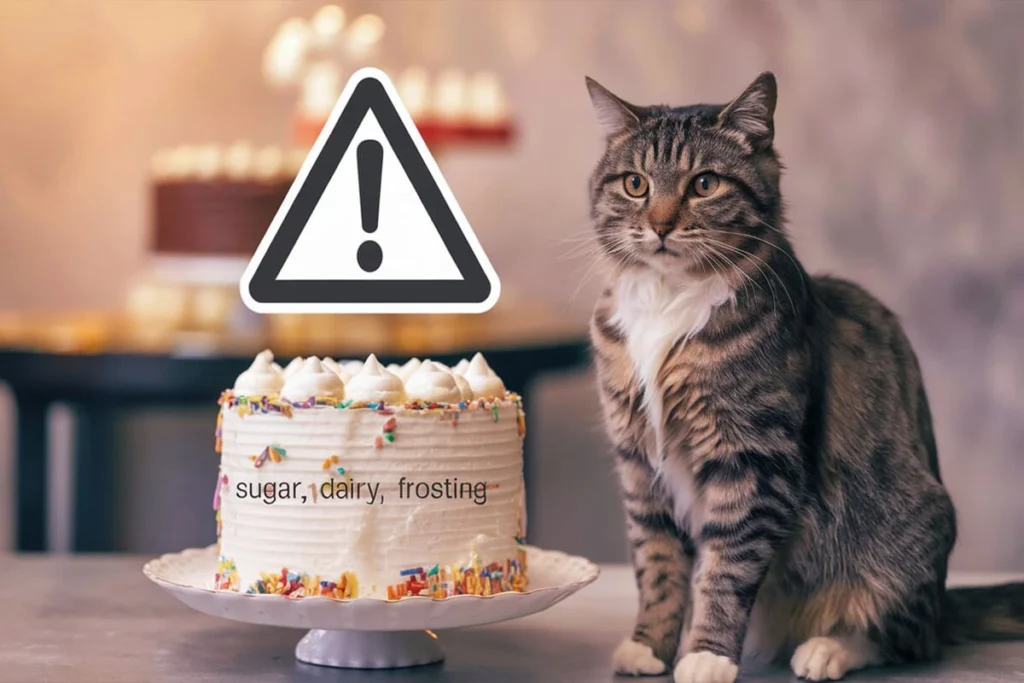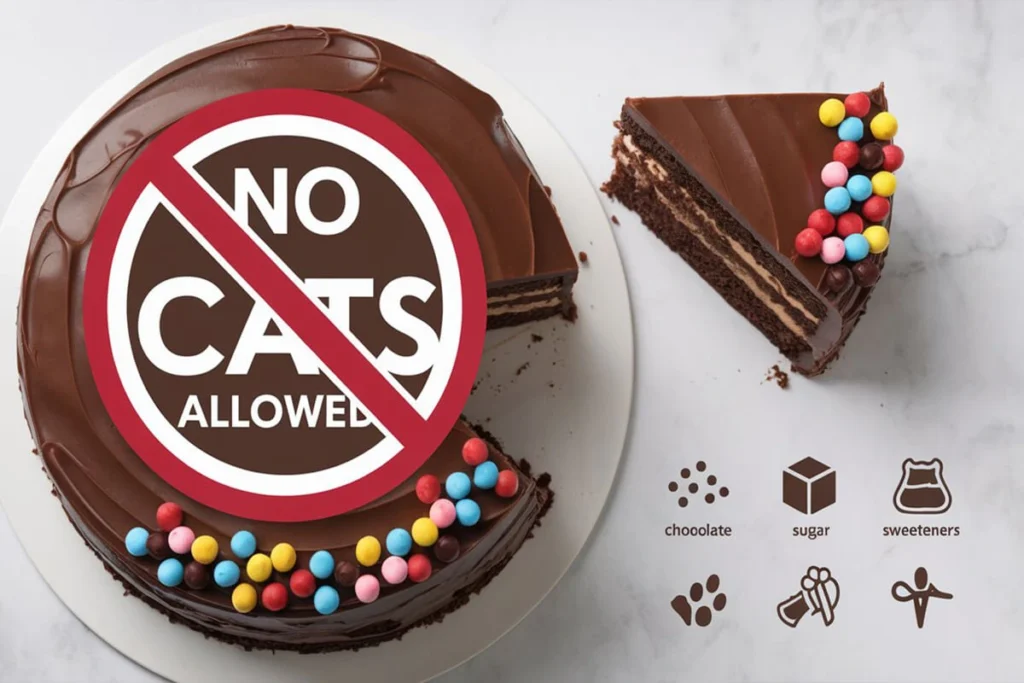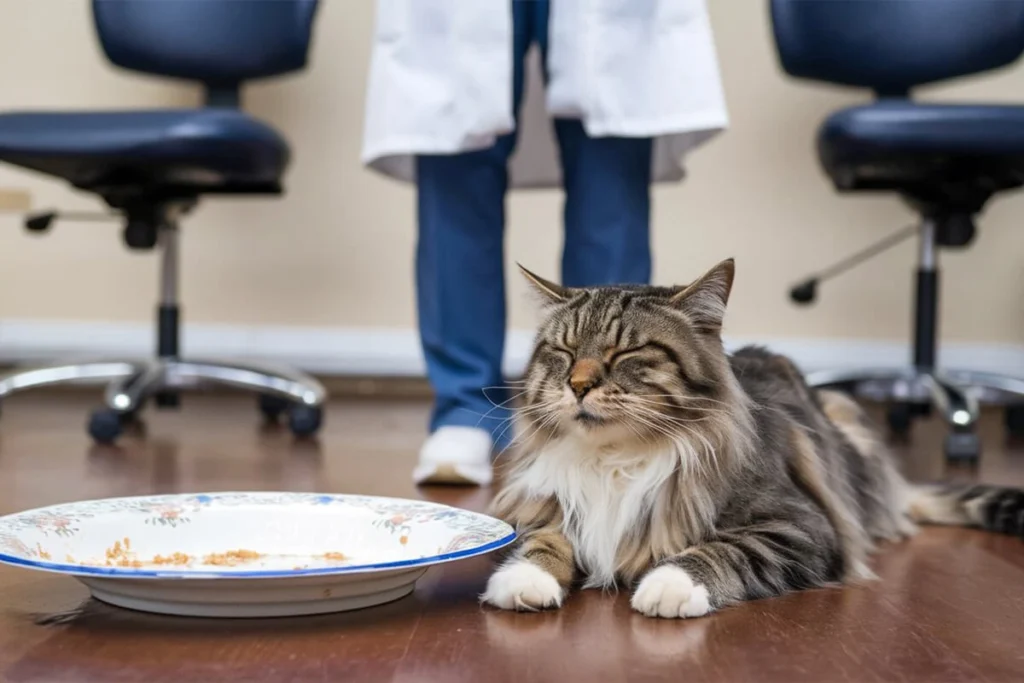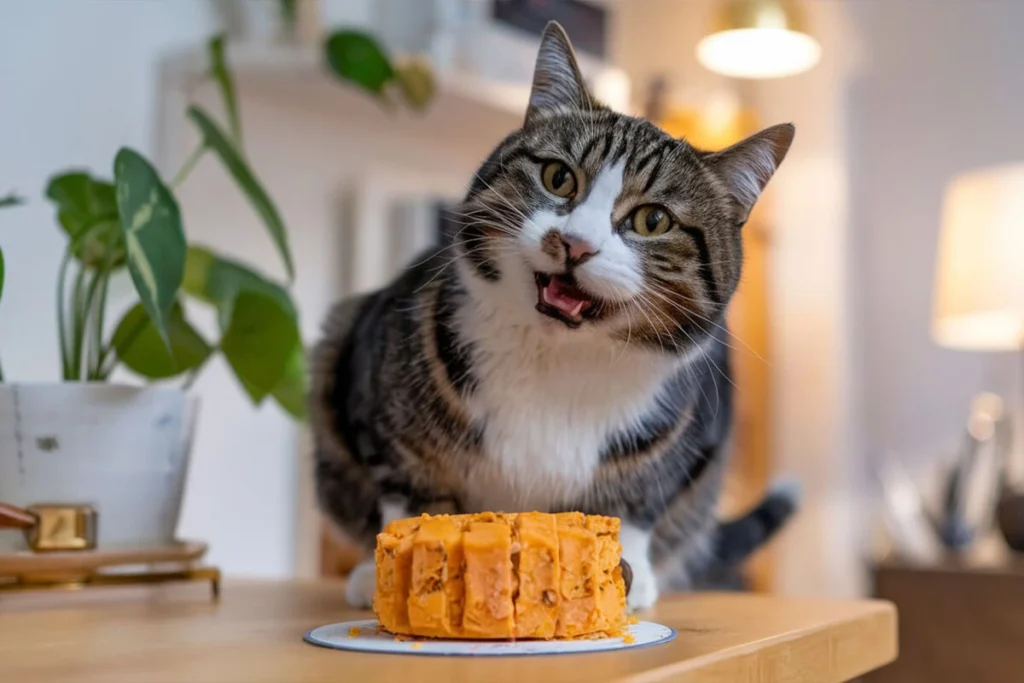People love watching funny videos of cats sniffing or pawing at cakes, but do cats love cake as much as social media makes it seem? Many cat owners have noticed their feline friends showing curiosity when they bring out a slice of cake, but that doesn’t mean it’s a safe or healthy treat for them. Cats have unique dietary needs, and their taste buds work differently from ours. Unlike humans, they don’t crave sweetness, so their interest in cake likely comes from the smell, texture, or even their bond with their owners rather than an actual love for dessert.
In this article, we’ll explore the truth behind the idea that cats love cake. We’ll break down whether cats can eat cake, why some ingredients can be dangerous, and what happens if they take a bite. Most importantly, we’ll provide safe and healthy alternatives so your feline friend can enjoy a special treat without any risks. If you’ve ever wondered whether your cat can share a slice of cake with you, keep reading to discover the surprising facts.
Do Cats Really Love Cake? Myth vs. Reality
Why Cats Seem Interested in Cake
Many cat owners have experienced the moment when they sit down with a delicious dessert, only to find their feline friend sniffing or pawing at their plate. This leads to the big question: do cats love cake? The short answer is no—but their curiosity makes it seem like they do. Cats rely heavily on their sense of smell, and cakes often have rich aromas from ingredients like butter, cream, and eggs. These scents can attract cats, even if they don’t actually want to eat the cake.
Another reason cats show interest in cake is their connection with their owners. Cats often want to explore whatever their humans are eating, not because they crave the food itself, but because they trust their owner’s choices. If you’re excited about your slice of cake, your cat might assume it’s something valuable and worth investigating. However, just because a cat sniffs or licks a cake doesn’t mean they enjoy it—or that it’s safe for them.
Do Cats Actually Taste Sweetness?
Many people assume that if a cat tries to eat cake, they must enjoy the sugary taste. However, science proves otherwise. Unlike people and many other animals, cats cannot taste sweet flavors. Their taste buds don’t register sugar the way ours do, so they can’t experience the same sweet flavors that make cake irresistible to us.
So why do some cats lick frosting or take a small bite of cake? In most cases, they’re reacting to the fat content rather than the sugar. Cakes contain butter, milk, and eggs—ingredients that provide a rich, fatty taste. Since cats are obligate carnivores, their bodies naturally crave fats and proteins, not sugar. If a cat seems to “love” cake, they’re likely drawn to the creamy texture or buttery aroma, not the actual sweetness.
Understanding Cat Behavior Around Human Food
Many cat owners assume that if their pet shows interest in human food, it must mean they like the taste. But in reality, a cat’s behavior around food is more complex. Cats are naturally curious creatures, and they explore the world through scent and texture. When a cat sniffs or licks cake, they might simply be investigating something new rather than seeking it out as a treat.
Some cats also develop food curiosity based on their environment. If a cat sees their owner regularly eating a certain type of food, they might become intrigued and want to mimic the behavior. This is especially true for cats that receive table scraps or treats from their owners—over time, they associate human food with rewards and may start begging for bites, even if the food itself isn’t suitable for them.
Even though cats love cake in terms of curiosity, their bodies aren’t designed to digest it. The sugar, dairy, and artificial ingredients in cakes can cause stomach upset, and in some cases, serious health issues. Understanding your cat’s natural instincts can help prevent them from eating something harmful and ensure they stick to a diet that keeps them happy and healthy.
Can Cats Eat Cake? Understanding the Risks
Common Cake Ingredients and Their Effects on Cats
Many cat owners wonder, “Do cats love cake?” and whether it’s safe for them to take a bite. The reality is that most cake ingredients can be harmful to cats, even in small amounts. Cakes contain a variety of ingredients that might seem harmless to humans but can cause digestive issues or more serious health problems for felines.

One of the biggest concerns is sugar, which is found in almost every cake recipe. Cats do not need sugar in their diet, and consuming it can lead to weight gain, diabetes, and other metabolic issues. While a small lick of frosting might not seem dangerous, regular exposure to sugary foods can have long-term consequences.
Flour is another common cake ingredient, but it doesn’t offer any nutritional value for cats. While not necessarily toxic, it can cause digestive discomfort, especially if a cat consumes large amounts. Since cats thrive on a high-protein diet, empty carbohydrates like flour provide no real benefit.
Another concern is artificial sweeteners, especially xylitol, which is extremely toxic to dogs and can also pose risks to cats. Even a small amount of xylitol can cause a dangerous drop in blood sugar, leading to lethargy, seizures, or even liver failure. While most traditional cakes don’t contain xylitol, sugar-free desserts and frosting substitutes might, making them especially dangerous for curious cats.
Why Sugar Isn’t Good for Cats
Many people assume that because cats show interest in cake, they must enjoy the sweet taste. However, cats lack the taste receptors for sweetness, so they don’t crave sugar the way humans do. Instead, their curiosity about cake comes from its smell, texture, and fat content rather than its sugary taste.
Even though cats don’t actively seek sugar, eating it can still negatively impact their health. The feline digestive system isn’t designed to process high amounts of carbohydrates, and excessive sugar consumption can lead to obesity, diabetes, and digestive problems. Unlike humans, who use carbohydrates as an energy source, cats rely primarily on protein and fats to stay healthy.
Eating sugar can also cause sudden energy spikes followed by crashes, making cats feel sluggish or unwell. Over time, a diet that includes too much sugar can lead to insulin resistance, increasing the risk of diabetes. Since cakes are loaded with sugar, even occasional bites can contribute to long-term health issues. If a cat eats cake regularly, the combination of sugar and other unhealthy ingredients can shorten their lifespan and reduce their overall well-being.
The Dangers of High-Fat Content and Dairy
Another reason cake is unhealthy for cats is its high-fat content. While cats do need healthy fats in their diet, the fats found in cake come from butter, cream, and oils, which are not ideal for feline digestion. Eating too much fat can lead to weight gain, pancreatitis, and other metabolic disorders.
One of the biggest concerns is dairy, which is commonly found in cakes. Many cakes contain milk, cream, and butter—all of which can cause digestive upset in cats. Despite the common stereotype that cats love milk, most adult cats are lactose intolerant. Their bodies don’t produce enough lactase, the enzyme needed to break down lactose, leading to stomach pain, diarrhea, and bloating.
Frosting is particularly dangerous because it combines sugar, dairy, and artificial flavoring. Even small amounts can cause vomiting, diarrhea, or an upset stomach. If a cat eats a cake with buttercream or whipped cream, they may experience gastrointestinal distress, making them uncomfortable for hours.
While cats love cake out of curiosity, their bodies are not built to handle its ingredients. High-fat and dairy-heavy desserts can lead to short-term discomfort and long-term health issues. Instead of letting a cat lick frosting or nibble on a cake slice, cat owners should focus on providing safe, feline-friendly treats that won’t put their pet’s health at risk.
The Most Dangerous Cake Ingredients for Cats
Chocolate: A Deadly Danger for Cats
Many people already know that chocolate is toxic to dogs, but some cat owners wonder, “Do cats love cake?” and whether a small bite of chocolate cake could harm their feline friend. The truth is that chocolate is one of the most dangerous ingredients a cat can consume. Even a small amount can cause severe health issues, and in some cases, it can be fatal.

Chocolate contains theobromine and caffeine, two compounds that cats cannot metabolize properly. When a cat ingests chocolate, these stimulants build up in their system, causing a range of dangerous symptoms. Depending on the amount consumed, a cat may experience restlessness, increased heart rate, tremors, vomiting, diarrhea, and even seizures. Dark chocolate and baking chocolate contain the highest levels of theobromine, making them even more toxic than milk chocolate.
If a cat eats chocolate cake, they are exposed to more than just the chocolate itself. Many chocolate cakes contain frosting, sugar, and dairy, which can further upset a cat’s digestive system. If a cat accidentally eats chocolate, a veterinarian should be contacted immediately, as the symptoms can worsen quickly.
Artificial Sweeteners (Xylitol): A Hidden Danger
While sugar is unhealthy for cats, artificial sweeteners—especially xylitol—can be even more dangerous. Xylitol is commonly used as a sugar substitute in sugar-free cakes, frosting, and baked goods. It is extremely toxic to dogs, and while research on its effects in cats is still limited, veterinarians warn that it can also be dangerous for felines.
The biggest risk of xylitol is a rapid drop in blood sugar levels, which can cause hypoglycemia. When a cat ingests xylitol, their body may release a surge of insulin, leading to dizziness, weakness, vomiting, and seizures. In severe cases, xylitol poisoning can cause liver failure and even death.
Many sugar-free desserts and diet-friendly baked goods contain xylitol, so cat owners should be extra cautious about leaving these items within reach. While cats love cake out of curiosity, they should never be allowed to taste anything that might contain artificial sweeteners. Even small amounts can lead to serious health problems, so it’s best to keep all sugar-free products away from cats.
Frosting and High Sugar Content: A Recipe for Trouble
One of the most tempting parts of a cake is the frosting, and many cat owners wonder if it’s safe to let their feline friend lick a little off the top. While frosting may not be as immediately toxic as chocolate or xylitol, it still poses serious health risks to cats.
Most frosting is packed with sugar, dairy, and artificial flavoring, all of which can cause digestive upset. Since cats lack the ability to process sugar properly, eating frosting can lead to vomiting, diarrhea, and stomach discomfort. Over time, consuming high amounts of sugar can contribute to obesity, diabetes, and dental problems.
Frosting often contains butter, cream, or milk, which can be problematic for lactose-intolerant cats. Even a small amount of dairy can trigger bloating, gas, and diarrhea. Additionally, some frostings use food coloring and preservatives, which may cause allergic reactions or irritation in sensitive cats.
Another concern is whipped cream-based or buttercream frosting, which contains high levels of fat. While cats need some fat in their diet, excessive amounts of unhealthy fats can lead to pancreatitis, a painful and potentially life-threatening condition. If a cat regularly consumes sugary or fatty foods like frosting, their long-term health will suffer.
Even though cats love cake and may be curious about frosting, it’s important for cat owners to resist the urge to share. Instead, offering a small, cat-safe treat is a much better way to satisfy a cat’s curiosity without risking their health.
What Happens if Your Cat Eats Cake?
Symptoms of an Upset Stomach or Toxicity
Many cat owners wonder, “Do cats love cake?” and assume a small bite won’t harm their feline friend. However, even a tiny amount of cake can cause digestive issues, and certain ingredients can lead to poisoning. If a cat eats cake, owners should watch for warning signs that indicate an upset stomach or toxicity.

The most common symptoms of an upset stomach include vomiting, diarrhea, excessive drooling, and a lack of appetite. A cat experiencing digestive discomfort may also act restless, meow more than usual, or avoid food and water. Some cats may try to hide because they feel sick and vulnerable.
If a cat consumes toxic cake ingredients like chocolate, artificial sweeteners (xylitol), or dairy, the symptoms can be much more severe. In cases of toxicity, a cat may show tremors, muscle weakness, increased heart rate, difficulty breathing, or even seizures. A cat that ingests a dangerous ingredient could also become extremely lethargic, collapse, or appear disoriented.
If we notice these symptoms early, it can help stop bigger problems from happening. If a cat shows mild signs of stomach discomfort after eating cake, their body may recover on its own. However, if symptoms worsen or signs of poisoning appear, immediate action is necessary.
When to Call the Veterinarian
If a cat eats cake, owners should assess the situation carefully. Not all cakes contain toxic ingredients, but some can be highly dangerous. Understanding when to call the veterinarian can make the difference between a quick recovery and a life-threatening emergency.
A veterinarian should be contacted immediately if a cat eats cake containing chocolate, xylitol, or other known toxic ingredients. Even if symptoms don’t appear right away, certain toxins take time to affect the body. Early veterinary intervention can prevent severe reactions.
Owners should also call a vet if their cat shows any of the following symptoms:
- Persistent vomiting or diarrhea that lasts more than a few hours.
- Lethargy or extreme weakness, especially if the cat refuses food or water.
- Tremors, seizures, or difficulty walking, which may indicate neurological effects.
- Rapid breathing, increased heart rate, or excessive drooling, which could signal poisoning.
- Abdominal pain or bloating, which may indicate a serious digestive issue.
Even if a cat only experiences mild symptoms, speaking with a vet can provide reassurance and guidance. The veterinarian may recommend monitoring the cat at home, providing fluids, or bringing them in for a check-up.
Immediate Steps to Take if Your Cat Eats a Harmful Ingredient
If a cat eats cake, owners should take immediate action to minimize any potential harm. The first step is to identify what ingredients were in the cake. Checking for toxic ingredients like chocolate, xylitol, dairy, and artificial additives can help determine whether the situation is an emergency.
If the cake contained chocolate or xylitol, owners should contact a vet or an emergency pet poison hotline right away. These ingredients are highly toxic, and delaying treatment could worsen the cat’s condition.
For non-toxic cake ingredients, owners can take the following steps:
- Remove any remaining cake to prevent the cat from eating more.
- Offer fresh water to help flush out any mild irritants from the digestive system.
- Monitor the cat closely for signs of stomach upset, such as vomiting, diarrhea, or lethargy.
- Avoid giving any human food or milk to “help” the cat, as dairy can make symptoms worse.
If a cat starts vomiting or showing signs of distress, a vet may advise bringing them in for an examination. In some cases, the veterinarian might induce vomiting or administer activated charcoal to prevent toxin absorption.
While cats love cake out of curiosity, their bodies are not designed to handle its ingredients. Taking quick action and seeking veterinary advice can help keep a cat safe and healthy. Instead of sharing cake with a feline friend, owners should provide cat-friendly treats that won’t put their pet at risk.
Safe and Healthy Alternatives: Cat-Friendly Desserts
Homemade Cat Treats: A Safe and Healthy Alternative
Many cat owners ask, “Do cats love cake?” and wonder if they can share their dessert with their feline friend. While cake is not a safe choice for cats, homemade cat treats can be a great alternative. By making treats at home, owners can control the ingredients and ensure they are both nutritious and enjoyable for their cats.

Since cats are obligate carnivores, their diet should be rich in protein and healthy fats rather than sugar and carbohydrates. Instead of baking a sugary cake, owners can make simple, protein-packed treats using ingredients like cooked chicken, tuna, salmon, or eggs. These ingredients provide essential nutrients and are much healthier than processed sweets.
Here are a few easy homemade cat treat ideas:
- Tuna & Egg Bites – Mix canned tuna with a beaten egg, shape into small pieces, and bake until firm.
- Chicken & Catnip Crisps – Blend cooked chicken with a little catnip, form small patties, and dehydrate for a crunchy texture.
- Salmon Puree Lickable Treats – Blend cooked salmon with a bit of water or unsalted bone broth to create a smooth puree that cats can lick up.
When making homemade treats, it’s important to avoid toxic ingredients like onions, garlic, chocolate, xylitol, or artificial flavorings. Keeping recipes simple and focused on natural, cat-friendly ingredients will ensure a happy and healthy pet.
Commercial Pet-Safe Treats: A Convenient and Healthy Option
If making homemade treats isn’t an option, many high-quality commercial pet-safe treats provide a safe and delicious alternative. While cats love cake, store-bought cat treats are specifically designed to meet their dietary needs without harmful additives.
When selecting commercial treats, owners should look for products that are:
- High in animal protein – Treats made with real meat (like chicken, turkey, or fish) are the best choice.
- Free from artificial preservatives – Avoid treats that contain artificial colors, flavors, or excessive fillers.
- Low in carbohydrates and sugar – Since cats don’t need sugar in their diet, the best treats contain minimal or no added carbohydrates.
Some great options for pet-safe treats include:
- Freeze-dried meat treats – These contain pure, single-ingredient proteins like chicken or salmon.
- Dental treats – Designed to help with oral hygiene while providing a tasty snack.
- Soft and chewy meat treats – Ideal for older cats or those who prefer a softer texture.
Owners should always check the ingredient list before buying treats and avoid products with unnecessary additives. Even though cats love cake out of curiosity, offering them a healthy, protein-packed snack is a much better choice.
Tips for Rewarding Your Cat with Safe, Healthy Snacks
Rewarding a cat with treats is a great way to reinforce positive behavior and strengthen the bond between pet and owner. However, it’s important to give treats in moderation and ensure they fit into the cat’s overall diet.
Here are some key tips for safely treating a cat:
- Use treats for training – Small, healthy treats can be a great reward when teaching commands or encouraging good behavior.
- Limit treat intake – Treats should make up no more than 10% of a cat’s daily caloric intake to prevent weight gain.
- Avoid table scraps – While cats love cake and other human foods, feeding them leftovers can lead to unhealthy habits.
- Offer variety – Rotate different flavors and textures to keep things exciting and prevent boredom.
- Incorporate treats into playtime – Hide treats in puzzle feeders or use them in interactive games to engage a cat’s natural hunting instincts.
Instead of sharing cake with a cat, owners should focus on providing nutritious, cat-friendly treats that support their pet’s health. Whether homemade or store-bought, choosing the right snacks will keep cats happy, satisfied, and safe from harmful ingredients.
Conclusion
The idea that cats love cake is more of a myth than reality. While many cats show curiosity when their owners enjoy a slice of cake, this interest doesn’t mean they actually crave or enjoy the dessert. Unlike humans, cats cannot taste sweetness, so their attraction to cake likely comes from its texture, fat content, or the simple desire to investigate something their owner is eating. However, just because a cat seems interested doesn’t mean cake is safe for them.
Cakes contain ingredients that can be harmful to cats, including sugar, dairy, chocolate, and artificial sweeteners like xylitol. Even a small bite can lead to digestive issues such as vomiting, diarrhea, or bloating. More dangerous ingredients, like chocolate or xylitol, can cause life-threatening conditions, including seizures or liver failure. If a cat accidentally eats cake, owners should monitor for signs of toxicity and contact a veterinarian if symptoms appear.
Instead of offering cake, cat owners should choose healthier alternatives. Homemade cat treats made from chicken, tuna, or salmon provide a nutritious and satisfying snack without the risks associated with human desserts. Commercial pet-safe treats also offer a convenient and safe way to reward a cat without exposing them to harmful ingredients.
While cats love cake in terms of curiosity, their health should always come first. Providing a balanced diet with cat-friendly treats ensures they stay happy, healthy, and safe. Next time you celebrate a special occasion, skip the cake for your feline friend and give them a treat that supports their well-being instead..
To Discover more of pets you can check This!
Get Some Good Stuff for your Cat From Pet MD Official

1 thought on “Do Cats Really Love Cake? The Shocking Truth Revealed”
Comments are closed.